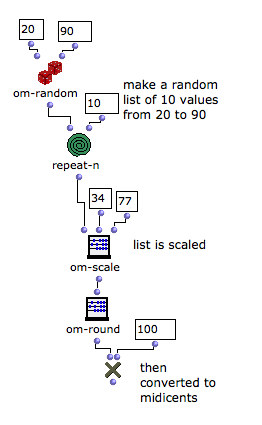Hello everyone,
I’m trying to build a patch that adapts any list of MIDIcs to a certain register (a min and a max MIDIcs value) through octave correspondence. In this case in particular I want to adapt a list of MIDIcs to a basson’s register, wich would be from 3400 to 7700 aprox. So I did it with two OMloops, the first one testing all the values from a list (listloop) and summing 1200 to values smaller than 3400. Then a second OMloop with a OMif testing values higher then 7700 and subtracting 1200. That is exactly where I have to improve my patch. I could altered the values but some of those values kept being smaller or grater then the register I need it. So I need a function that keeps adding or subtracting 1200 until this number is comprised between 3400 and 7700. I tried using and but I can’t figure out how to connect them to a OMif! There are only a few examples in OM tutorials and none of them presented the solution. Does someone have the answer to this?
Thanks!



